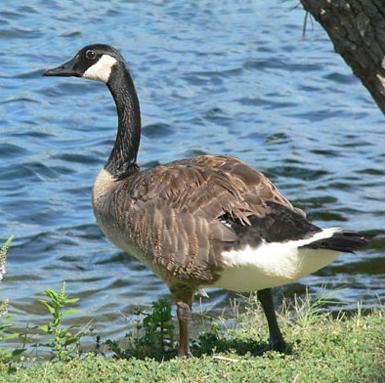Goose - Canada
Scientific Name: Branta canadensis
Fri, 4th July, 2025 - 5:24 am GMT
Sponsor Ads:

Alternative Name
Scientific Name: Branta canadensisBasic Info
Depending upon the region they derive from, the Canada Goose may vary in appearance. The wingspans of these geese range between 90 centimeters and two meters! Generally, the geese have black crowns, heads, and necks. Their cheek patches are white. The undersides of Canada Geese range in color from grayish white to blackish brown. The most common body color is a dark grayish shade.
Health
In order to manage Canada Geese, their legs are usually tagged. These animals will generally be specific to one breeding area and if depleted, other populations will usually not populate the empty area. Breeding Canada Geese usually breed in wet, secluded areas. Islands or clumps of waterside vegetation are common nesting sites. Other times, waterlogged clumps of vegetation far from bodies of water may be used. When breeding, Canada Geese have difficulty finding food and usually eat little. A clutch of five to seven eggs is usually laid, which will incubate for an average of 28 days. While the female goose incubates the eggs, the male goose guards the site. After hatching, the geese stay together. Usually when they move, the female leads, the goslings follow, and the male brings up the rear of the troop.Habitat
N/ABehavior
Many North Americans mark the change in seasons with the romantic image of Canada Geese flying in V formation across the autumn skies. As beautiful as they are predictable, these birds are well worth the notice! Canada Geese usually mate for life. Generally, Canada Geese migrate from feeding grounds to breeding grounds regularly each year. They fly in a V formation in loose groups. Although some will simply move a short distance away, others will migrate down from Canada all the way to Mexico! Migration may take longer some years than others; even when the geese reach their breeding grounds, they may be driven south again by late spring storms. Early on in the migration, Canada Geese gain a layer of fat, which allows them to tolerate harsh weather for a short period. When a pair of Canada Geese and their young encounters another family group, confrontations generally occur. The geese will make noises at each other and pose threateningly. Usually, it is the size of the group, however, which determines the winner. The gander, or male goose, defends the family and a blow from one of his powerful wings may cause formidable deterrence! Smaller groups defer to larger groups. In the wild, Canada Geese will feed on berries and tufted marsh plants, although they will not refuse grains if they find fields available to them!Origin
CanadaHistory
Native to North America, Canada Geese generally breed in Canada. They have flourished in modern times due to improving farming techniques and will frequently eat grain. Because of their increase in numbers, Canada Geese have become somewhat of a nuisance in many suburban areas due to lack of predators and hunters. In wilder areas, the Canada Goose is hunted and is highly valued by many as a trophy. Others, including environmentalists, ornithologists, and photographers, love observing the majestic Canada Goose in its natural habitat.Common Foods
N/ASponsor Ads:
When the hounds bay, the fox and the rabbit are brothers. -- Unknown
Goose - Canada
Coded by: BGID® | ALL RIGHTS RESERVED Copyright © 2000-2025
Disclaimer | Privacy | Report Errors / Contact | Credits








 President of the United States of America - Real Estate mogul, Pageant owner and now one of the most controversial men in political history.
President of the United States of America - Real Estate mogul, Pageant owner and now one of the most controversial men in political history.  Global warming has been in and out as the "latest" hot topic for many years. It is, according to modern scientists, the result of man-made industrial pollutants, clearing forested areas, agriculture, etc. But now they are thinking it started way before the Industrial Revolution...
Global warming has been in and out as the "latest" hot topic for many years. It is, according to modern scientists, the result of man-made industrial pollutants, clearing forested areas, agriculture, etc. But now they are thinking it started way before the Industrial Revolution...  Politician, US Vice President and President of the USA - Joseph Robinette Biden Jr.
Politician, US Vice President and President of the USA - Joseph Robinette Biden Jr.  versus
versus  Russia: 'The Evil Empire'? Are they all that bad or is it just the USA trying to portray Russia as bad because they are a world power with land bigger and a society very different from the USA ideal?
Russia: 'The Evil Empire'? Are they all that bad or is it just the USA trying to portray Russia as bad because they are a world power with land bigger and a society very different from the USA ideal? 
 Corona virus
Corona virus 
 Users with wide screen monitors can benefit from more content on every page.
Users with wide screen monitors can benefit from more content on every page.